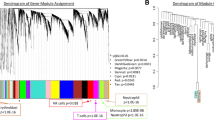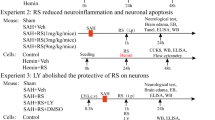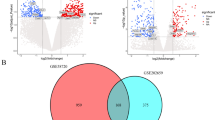Abstract
Inflammatory responses after intracerebral hemorrhage (ICH) contribute to severe secondary brain injury, leading to poor clinical outcomes. However, the responsible genes for effective anti-inflammation treatment in ICH remain poorly elucidated. The differentially expressed genes (DEGs) of human ICH were explored by online GEO2R. Go and KEGG were used to explore the biological function of DEGs. Protein–protein interactions (PPI) were built in the String database. Critical modules of PPI were identified by a molecular complex detection algorithm (MCODE). Cytohubba was used to determine the hub genes. The mRNA-miRNA interaction network was built in the miRWalk database. The rat ICH model was applied to validate the key genes. A total of 776 DEGs were identified in ICH. Go and KEGG analyses indicated that DEGs were mainly involved in neutrophil activation and the TNF signaling pathway. GSEA analysis presented that DEGs were significantly enriched in TNF signaling and inflammatory response. PPI network was constructed in the 48 differentially expressed inflammatory response-related genes. The critical module of the PPI network was constructed by 7 MCODE genes and functioned as the inflammatory response. The top 10 hub genes with the highest degrees were identified in the inflammatory response after ICH. CCL20 was confirmed as a key gene and mainly expressed in neurons in the rat ICH model. The regulatory network between CCL20 and miR-766 was built, and the miR-766 decrease was confirmed in a human ICH dataset. CCL20 is a key biomarker of inflammatory response after intracerebral hemorrhage, providing a potential target for inflammatory intervention in ICH.






Similar content being viewed by others
Data Availability
All the datasets that support the findings of this study are available from the Gene Expression Omnibus at http://www.ncbi.nlm.nih.gov/geo/, including GSE24265, GSE171144, and GSE43618 series.
References
Zia, E. et al. 2007. Blood pressure in relation to the incidence of cerebral infarction and intracerebral hemorrhage. Hypertensive hemorrhage: debated nomenclature is still relevant. Stroke 38(10): 2681–5.
Keep, R.F., Y. Hua, and G. Xi. 2012. Intracerebral haemorrhage: Mechanisms of injury and therapeutic targets. Lancet Neurology 11 (8): 720–731.
Xue, M., and V.W. Yong. 2020. Neuroinflammation in intracerebral haemorrhage: Immunotherapies with potential for translation. Lancet Neurology 19 (12): 1023–1032.
Gross, B.A., B.T. Jankowitz, and R.M. Friedlander. 2019. Cerebral Intraparenchymal hemorrhage: A review. JAMA 321 (13): 1295–1303.
Aronowski, J., and X. Zhao. 2011. Molecular pathophysiology of cerebral hemorrhage: Secondary brain injury. Stroke 42 (6): 1781–1786.
Wang, J. 2010. Preclinical and clinical research on inflammation after intracerebral hemorrhage. Progress in Neurobiology 92 (4): 463–477.
Guo, Y. et al. 2022. Mechanism and regulation of microglia polarization in intracerebral hemorrhage. Molecules 27(20).
Tschoe, C., et al. 2020. Neuroinflammation after intracerebral hemorrhage and potential therapeutic targets. J Stroke 22 (1): 29–46.
Scimemi, A. 2018. Astrocytes and the warning signs of intracerebral hemorrhagic stroke. Neural Plasticity 2018: 7301623.
Liddelow, S.A., et al. 2017. Neurotoxic reactive astrocytes are induced by activated microglia. Nature 541 (7638): 481–487.
Yuan, G., et al. 2023. Receptor-interacting protein 3-phosphorylated Ca(2+) /calmodulin-dependent protein kinase II and mixed lineage kinase domain-like protein mediate intracerebral hemorrhage-induced neuronal necroptosis. Journal of Neurochemistry 164 (1): 94–114.
Yu, G., et al. 2012. clusterProfiler: An R package for comparing biological themes among gene clusters. OMICS: A Journal of Integrative Biology 16 (5): 284–287.
Bader, G.D., and C.W. Hogue. 2003. An automated method for finding molecular complexes in large protein interaction networks. BMC Bioinformatics 4: 2.
Chin, C.H., et al. 2014. cytoHubba: identifying hub objects and sub-networks from complex interactome. BMC System Biology 8(Suppl 4): S11.
Dweep, H., et al. 2011. miRWalk–database: Prediction of possible miRNA binding sites by “walking” the genes of three genomes. Journal of Biomedical Informatics 44 (5): 839–847.
Takaoka, Y., et al. 2016. Retinoic acid receptor agonist Am 80 inhibits CXCL2 production from microglial BV-2 cells via attenuation of NF-κB signaling. International Immunopharmacology 38: 367–376.
Zhu, H., et al. 2019. Role and mechanisms of cytokines in the secondary brain injury after intracerebral hemorrhage. Progress in Neurobiology 178: 101610.
Ziai, W.C., et al. 2021. Early inflammatory cytokine expression in cerebrospinal fluid of patients with spontaneous intraventricular hemorrhage. Biomolecules 11(8).
Landreneau, M.J., et al. 2018. CCL2 and CXCL10 are associated with poor outcome after intracerebral hemorrhage. Annals of Clinical Translational Neurology 5 (8): 962–970.
Leasure, A.C., et al. 2021. Association of serum IL-6 (interleukin 6) with functional outcome after intracerebral hemorrhage. Stroke 52 (5): 1733–1740.
Guo, F., et al. 2020. Chemokine CCL2 contributes to BBB disruption via the p38 MAPK signaling pathway following acute intracerebral hemorrhage. The FASEB Journal 34 (1): 1872–1884.
Xu, D., et al. 2021. Sphingosine-1-phosphate receptor 3 is implicated in BBB injury via the CCL2-CCR2 axis following acute intracerebral hemorrhage. CNS Neuroscience & Therapeutics 27 (6): 674–686.
Yan, J., et al. 2020. CCR1 Activation promotes neuroinflammation through CCR1/TPR1/ERK1/2 signaling pathway after intracerebral hemorrhage in mice. Neurotherapeutics 17 (3): 1170–1183.
Yan, J., et al. 2022. Met-RANTES preserves the blood-brain barrier through inhibiting CCR1/SRC/Rac1 pathway after intracerebral hemorrhage in mice. Fluids Barriers CNS 19 (1): 7.
Walsh, K.B., et al. 2019. Intracerebral hemorrhage induces monocyte-related gene expression within six hours: Global transcriptional profiling in swine ICH. Metabolic Brain Disease 34 (3): 763–774.
Schutyser, E., S. Struyf, and V. Damme. 2003. The CC chemokine CCL20 and its receptor CCR6. J Cytokine growth factor reviews 14 (5): 409–426.
Ranasinghe, R. and R. Eri. 2018. Modulation of the CCR6-CCL20 axis: a potential therapeutic target in inflammation and cancer. Medicina (Kaunas) 54(5).
Meitei, H.T., N. Jadhav, and G. Lal. 2021. CCR6-CCL20 axis as a therapeutic target for autoimmune diseases. Autoimmunity Reviews 20 (7): 102846.
Hayakawa, K. et al. (2019) MicroRNA-766–3p contributes to anti-inflammatory responses through the indirect inhibition of NF-κB signaling. International Journal of Molecular Science 20(4).
Funding
This work was supported by the Chinese Government Scholarship from the Chinese scholarship council (CSC NO.202206920038).
Author information
Authors and Affiliations
Contributions
Zhong Wang performed the study concept and design; Zong-Qing Zheng and Gui-Qiang Yuan performed most of the experiments and bioinformatic analysis; Zong-Qing Zheng and Gui-Qiang Yuan provided acquisition, analysis, and interpretation of data and statistical analysis; Guo-Guo Zhang, Yan-Ting Chen, and Qian-Qian Nie provided technical and material support. Zong-Qing Zheng and Gui-Qiang Yuan conducted the writing, review, and revision of the paper; Zhong Wang supervised the project. All authors read and approved the final paper.
Corresponding author
Ethics declarations
Ethics Approval
Animal experiments were conducted following the National Research Council’s Guide for the Care and Use of Laboratory Animals. The experimental protocols were approved by the Ethics Committee of the First Affiliated Hospital of Soochow University.
Consent to Participate
Not applicable.
Consent for Publication
Not applicable.
Competing Interests
The authors declare no competing interests.
Additional information
Publisher's Note
Springer Nature remains neutral with regard to jurisdictional claims in published maps and institutional affiliations.
Rights and permissions
Springer Nature or its licensor (e.g. a society or other partner) holds exclusive rights to this article under a publishing agreement with the author(s) or other rightsholder(s); author self-archiving of the accepted manuscript version of this article is solely governed by the terms of such publishing agreement and applicable law.
About this article
Cite this article
Zheng, ZQ., Yuan, GQ., Zhang, GG. et al. Identification of CCL20 as a Key Biomarker of Inflammatory Responses in the Pathogenesis of Intracerebral Hemorrhage. Inflammation 46, 1290–1304 (2023). https://doi.org/10.1007/s10753-023-01807-4
Received:
Revised:
Accepted:
Published:
Issue Date:
DOI: https://doi.org/10.1007/s10753-023-01807-4




